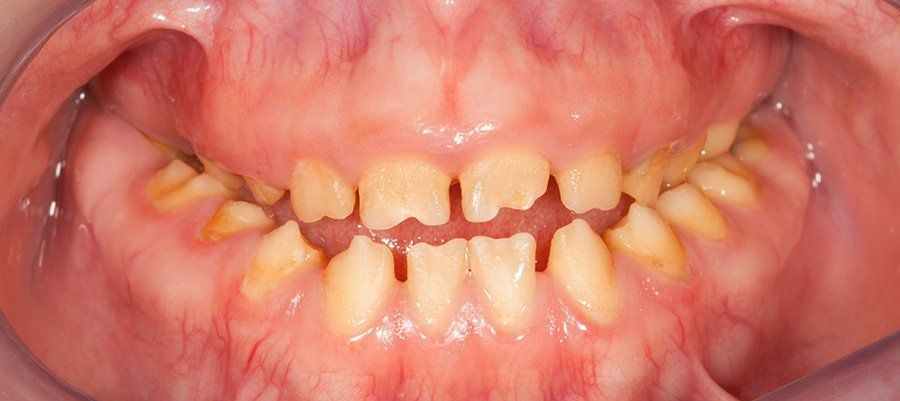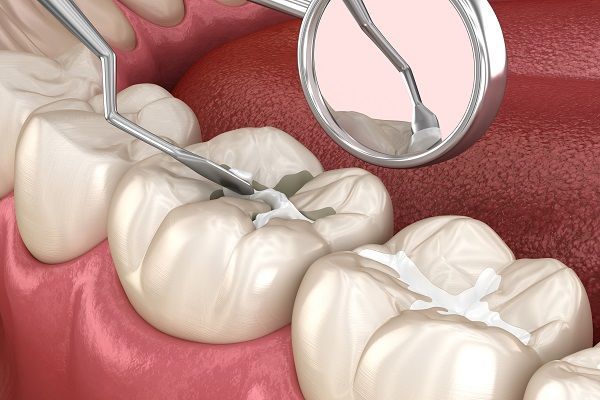Amelogenesis imperfecta is a hereditary dental disease that affects 1 in 14,000 people in the United States. Occurring in early childhood and persisting into adulthood and beyond, people with this rare genetic condition cannot produce the functional proteins necessary to create and lay down effective enamel. Therefore, their teeth are small, discolored, misshapen, and fragile. In most cases, they require professional dental work to preserve or replace teeth.

What are the symptoms of amelogenesis imperfecta?
This dental abnormality can cause specific symptoms that affect the teeth and bite, including:
- Brown, yellow, gray, or white (snow-capping) teeth
- Smaller-than-normal teeth
- Uneven, ridged, or lumpy teeth
- Soft, thin, or brittle enamel
- Extreme tooth sensitivity
- Open bite (malocclusion)
Some additional risks and complications associated with amelogenesis imperfecta include:
- Dental cavities and/or decay
- Tooth wear, chipping, and cracking
- Excess tartar buildup
- Infection of the tissues and bone surrounding teeth
- Large or swollen gums (gingival hyperplasia)
If your child is experiencing the signs and symptoms listed above, call us now at (855) 328-6646 to schedule a dental exam and rule out the possibility of amelogenesis imperfecta.
What are the causes?
Mutation in the AMELX gene, ENAM gene, or MMP20 gene is the cause of amelogenesis imperfecta. These genes are responsible for creating the proteins required to properly form the protective outer layer of teeth (enamel). An unusual change in any one of these genes can prevent it from producing the correct protein, leading to thin or soft enamel.
As mentioned, parents can pass down the mutated gene to their children. However, people with no family history of amelogenesis imperfecta can also develop the disease.
How do dentists diagnose it?
Thorough assessments of the patient’s family history and dental characteristics are essential to diagnosing amelogenesis imperfecta. Genetic testing and X-ray imaging may also be used to help determine the cause and heritability of the disease and classify the disease by type.
The classification systems have evolved. Some examine the physical qualities of teeth to classify the disorder, while others use the heritability and underlying genetic cause as primary or secondary diagnostic labels.
What are the types of amelogenesis imperfecta?
The physical attributes of teeth captured during an X-ray examination help define the four types of amelogenesis imperfecta. These include:
- Type 1 (hypoplastic). The teeth’ crowns may be noticeably smaller than normal, with deep grooves in the tooth’s enamel. The teeth may appear discolored, and an open bite prevents the upper and bottom front teeth from meeting.
- Type 2 (hypomaturation). The enamel may be discolored and has a rough, pitted texture with normal thickness. The enamel is often brittle and prone to breakage and sensitivity. Similar to the first type of amelogenesis imperfecta, an open bite may be present.
- Type 3 (hypocalcified). Type 3 has identical characteristics to Type 2. The difference is that tartar build-up is faster, and the enamel appears chalky. Also, the enamel is thin, soft and susceptible to chipping or cracking.
- Type 4 (hypomaturation-hypoplasia with taurodontism). In most cases, the teeth appear smaller and discolored. Spotting may be present, the enamel is relatively thinner, and pits are noticeable. Taurodontism is when the pulp chamber, the soft area in the center of the tooth, is larger than normal.
Children can inherit different forms of amelogenesis imperfecta dominantly, recessively, as well as with irregularities present on the X chromosome. Some genetic mutations follow one specific inheritance pattern, while others are inherited in several ways—particularly the ENAM gene.
What are the treatments for amelogenesis imperfecta?
The available treatments for this rare dental disease aim to:
- Preserve teeth and enamel
- Maintain or restore healthy dental functions
- Address psychosocial issues, including a cosmetic appearance
- Alleviate pain associated with the condition
Early treatment of amelogenesis imperfecta involves professional dental services in California to protect and preserve an infant’s teeth as they come in. Normal development of teeth should be promoted as much as possible.
Currently, there is no standard treatment for amelogenesis imperfecta. Treatment will depend on the type and severity of the condition. A dental specialist will also consider the age of the patient and the overall condition of their teeth.
Some treatment options for amelogenesis imperfecta include:
1. Bonding
Teeth bonding is a dental procedure that involves attaching high-density, modern plastics called composite resins to teeth to conceal and fill in gaps. Dentists in Irvine and Montclair, CA, often recommend bonding procedures to people with Type 1 amelogenesis imperfecta because their teeth are typically durable enough to hold on to the bond.
2. Crown restoration
A zirconia dental crown is a tooth-shaped cap that dentists place over an existing tooth. It helps restore a damaged tooth’s shape, size, and overall appearance.
In the hypomaturation and hypocalcified types, the enamel is often too frail to hold on to bonded restorations. Dental crowns are among the most durable options for Type 1 and 2 amelogenesis imperfecta. Crowns also play a role in protecting against tooth decay.
Dentists can create temporary dental crowns of porcelain, stainless steel, or gold for children or adolescents with the rare condition. Permanent crowns become an available option in early adulthood or once all of the patient’s secondary teeth are present and stable.
3. Orthodontic treatment
People with amelogenesis imperfecta, especially those with an open bite, may need orthodontic treatment such as braces or Invisalign. In many cases, these dental appliances’ goal is not to make the teeth look straight and perfect but rather to shift the teeth in a better position for restorations.
4. Dentures, overdentures and implant supported prosthesis
A denture is a removable artificial device designed to mimic the appearance and function of real teeth. Overdentures, unlike traditional dentures, use dental implants to ensure a secure fit. Implant supported fixed prosthesis provide the best option to restore a smile.
If tooth decay due to amelogenesis imperfecta has progressed too far, a dentist may need to remove or extract all unsalvageable teeth. In this scenario, replacing any missing teeth with one of these three treatments will be necessary.
A Word From 24/7 Local Dentist
Children growing up with amelogenesis imperfecta may feel embarrassed by the appearance of their smile, which, in turn, may impact their social lives. This embarrassment may lead to hiding their teeth when talking or smiling, ultimately pulling their confidence down. Furthermore, if left untreated, the enamel and teeth can break. The damage can be excruciating and will leave the patient with an unattractive smile.
Early restoration may lead to healthy peer relationships at a crucial time in social development. If your child (or yourself) needs amelogenesis imperfecta treatments in California, call us today at (833) 220-2448 to schedule a consultation.










